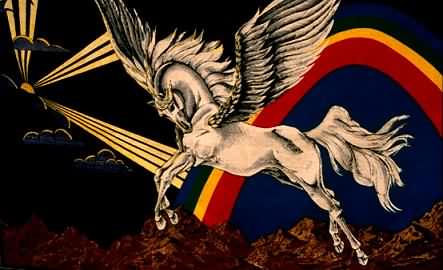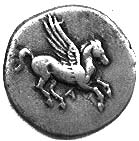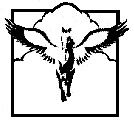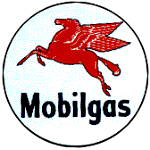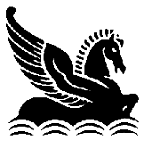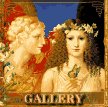|
MYTH MAN'S
HOMEWORK HELP PEGASUS Pegasus (Pegasos) in Greek Mythology is the winged horse born when the Greek hero Perseus cut off the Gorgon Medusa's head. Pegasus caused Hippocrene, the fountain of the Muses on Mount Helicon, to well forth with a stroke of his hoof. His name is possibly derived from 'springs of the Ocean' (pegai) or 'of the wells.' It is a variant of the Greek word pege which means "spring" or "fountain" and the form sus is pre-Greek in origin - it means "bridled horse" referring to the figurehead of a ship. Thus Pegasus can literally mean "Fountain Horse." PEGASUS IN POINT FORM
SOME
MARVELOUS DETAILS FROM When the Gorgon Medusa was decapitated by the hero Perseus, Pegasus and his brother, Chrysoar, were born from the mix of seafoam and blood. Ridden by Perseus, he carried the hero over the sea and aided in the defeat of Cetus, the Sea-dragon, and the rescue of the Princess Andromeda. After this adventure, the young colt was gathered by Athena (Minerva) and carried to Mt. Helicon where she entrusted the Muses with his care. In his excitement young Pegasus struck the ground with his hooves and cause the springs of Aganippe and Hippocrene to gush forth their bounty of inspiration. Urania, the Muse of Astronomy and Universal Love (also an aspect of Aphrodite) showed the most interest in his rearing. Prophesying of his future heroic deeds and eventual celestial honor she grieved the most when Bellerophon, at Athena's beckoning, came to take Pegasus away from Mt. Helicon. After the many long years of heroic deeds Pegasus had accomplished in the companionship of Bellerophon, and the hero's thankless death, Urania was enraptured by Pegasus' triumphant arrival to Mt. Olympus. (The tragic ending of the tale of Bellerophon would seem to be a shrewd illustration of the folly of assuming that something or someone is subject to our will and cannot function successfully without us. The Greeks may have also attempted to tell us that simply being a member of the human race does not, in itself, warrant our acceptance into the transcendental realms. The simple fact that it was the Horse and not the Man must surely convey something of the status of man in the universal scheme of things.) (The Pegasus Syndrome, as exemplified in the legends of Perseus and Bellerophon, is concerned with the innate ability possessed by some people to negotiate difficulties by rising above them, on the one hand, and the danger of overreaching themselves, on the other. Pegasus, by birth, is the child of Medusa and Neptune, symbols of 'wisdom' and 'emotion,' respectively, which shows the dichotomy of his nature. As in the story, Bellerophon attempted to fly to Olympus (overreach his potential). He believed that Pegasus was subject to his will. However, it was Pegasus who made it to Olympus, while Bellerophon was tossed back to earth, lame and reproached by others. It is unwise to take any situation for granted as the 'lesser' person (or, in this case, beast) may be the very one to teach us the much-needed lesson in humility. Pegasus is also indicative of a specific mission in life which the inquirer will always find the time and energy to pursue, although the path may be sewn with difficulties (the Chimaera) and limitations (Bellerophon's doubt or arrogance). So, the Pegasus Syndrome is the seeming ability to "fly over any situation," though the reverse may be a lesson in humility, being "taken down a peg," as it were.) Pegasus went on to become the occasional mount of the goddess Eos (Aurora) on her mission to bring forth the Dawn. At other times he was ridden by Apollo (Phoebus) as he brought the sun across the sky. And, even more importantly, Pegasus served as Zeus' Lightning Bearer, when Pegasus' own hooves could be heard thundering across the skies in a storm. As a tribute to his exceptional life and heroic deeds, Zeus honored Pegasus with a constellation in the sky. According to an amalgam of several other myths stemming from Cheiron's progeny, there is a formidable afterlife for Pegasus involving a wife, Euippe (or Ocyrrhoe), and two children, Celeris and Melanippe. In poetry, the phrase "My Pegasus will not go this morning" means the author's brain will not work (lacks inspiration), and "I am mounting my Pegasus" means he's going to write (he's becoming inspired), and "I am on my Pegasus" means he's engaged in writing. MORE
FROM The Pegasus Constellation is situated to the north of the Urn of Aquarius and the eastern fish of the constellation Pisces. Most notably, four of its brightest stars form the Great Square, however, Pegasus is confusingly flying upside down. The Greeks called the constellation Hippos, though sometimes Hippos Ieros (the divine horse) and there are many related or derived terms, including the Latin Equus, Equus Ales, Alatus (winged), Sonipes (noisy-footed), and so on. It is suggested that the jackal-like animal on the Denderah Zodiac represents at least part of Pegasus. It's five brightest stars are Markab (the saddle), Scheat (the upper arm), Algenib (the side or wing) which, along with Alpheratz or Sirrah (navel of the steed) which is alpha Andromedae (but sometimes called delta Pegasi) form the Great Square. Other important stars in Pegasus are Enif (the nose), Homan (lucky star of the hero) and Matar (fortunate rain). In Astrology, Ptolemy associates its brightest star with the influence of Mercury conjunct Mars, and the constellation is said to bring ambition, vanity, enthusiasm, and bad judgment. Ancient astrologers believed that all the stars of Pegasus protected horsemen in battle. In the so-called Lost Zodiac, those persons born between March 13 and April 1 are said to be born under the sign of Pegasus. Because of horseshoes the hoof-marks which horses leave behind look like crescent moons, horses in Greece were sacred to the Moon, which, as it lights up the darkness of the night, governs the world of imagination, instinct and intuition to which the horse also belongs. The moon was also thought to be the source of all moisture, and it was believed to be the moon-shaped hooves of Pegasus, that, when they struck the flowering earth, had caused the Muses' fountain of poetic inspiration to start flowing. The moonlit realm of the imagination, of visions, dreams and intuition, is where those born under the sign of the winged stallion, Pegasus, feel most confident and at home. GREAT
CEREBRAL STUFF FROM SYMBOLISM Horses are a potent symbol from almost every world religion and mythology. Many of its myths express the horse's innate clairvoyance and ability to perceive the magic within humans. Some view the horse as the symbol of strength, virility and lust. According to popular belief it loses its sexual powers when its mane is cut, and is the only animal which shows sorrow because it weeps for its dead master (though this is later belief is not exclusive to the Horse-Human relationship). Also, it is a symbol for loyalty and devotion, such as the faith it has with it's master. It also represents the warrior spirit, bravery and courage. Wings are a symbol that denotes "flight" and often represent prayer and contemplation, especially in the sense of feathered bird-like wings. A spiritual or religious symbol they represent the soul's ability to transcend the weight of earthly burdens and rise above such concerns into the air, even to Heaven itself, to the presence of God. In Christian symbolism, through demonization, there are also the accursed wings of such infernal creatures as vampires, basilisks, dragons and others. These are the leathery wings of skin, like those of a bat, whose appearance adds to the attributes of evil inherent in the beast. "Skin" being a symbol of the carnal nature of man, therefore sinful, is connected to the to the idea of the perversion of the intellectual faculties toward evil purposes. Azrael, the Angel of Death, is often depicted with leathery wings, (i.e., the satyr-like devil, Satan [the former Angel of Light, Lucifer] the Destroyer). These are the typical wings of the Hellhorse or the Chimaera. TheWinged Horse or Pegasus symbolizes heightened power of the natural forces - the innate capacity for spiritualization and for inverting evil into good. As a Christian and religious symbol, Pegasus was adopted from the attribution as the mount of Apollo, the God of pure light, beauty and truth to be included in the symbolic fauna of Christ. Winged horses, in general, symbolize the transport of the soul of the deceased Christian to Heaven, and figuratively, like Apollo the Sun-god, represents Christ lifted up and, like the sun, 'Full of Glory,' and as the Revealer of Mysteries and the causer of refreshing (as in the passage: "They that wait upon the Lord shall renew their strength, they shall mount up with wings as eagles..." - Isaiah 40:31). Also, during the Apocalypse, Pegasus has been compared to the "white horse" whom the conqueror rides in the book of Revelation in the Bible. Aside from being a general symbol of creative inspiration and poetry, the flying horse is an expression for speed, power and swift transport. As an animal totem, Pegasus symbolizes the immortality of the soul, and serves as the carrier and protector of the spirit in its journeys to the astral plane (especially to the Moon - the emotional plane). Pegasus is closely linked to the Greek gods Poseidon (Neptune) [emotion ], his father; Athena (Minerva) [heavenly wisdom ], his protectress; Zeus (Jupiter) [guidance & creativity ] as his Thunder-bearer; and the Muse Urania [heavenly love ], his nursemaid, and the Muses [inspiration, memory and the arts ] in general; the heroes Perseus [intellect ] and Bellerophon [impudence ]; and the monsters Medusa [mortal wisdom ] and Chimaera [complex evil ]. PEGASUS
ON ANCIENT COINS PEGASUS
AND THE CHIMERA BY When Perseus
cut off Medusa's head, the blood sinking into the earth produced the
winged horse Pegasus. Minerva (Athena) caught and tamed him and presented
him to the Muses. The fountain Hippocrene, on the Muse's The Chimaera
was a fearful monster, breathing fire. The fore part of its body was a
compound of the lion and the goat, and the hind part a dragon's. It made
great havoc in Lycia, so that the king, Iobates, sought for some hero to
destroy it. At that time there arrived at his court a gallant young
warrior, whose name was Bellerophon. He brought letters from Proetus, the
son-in-law of Iobates, recommending Bellerophon in the warmest terms as an Iobates, on perusing the letters, was puzzled what to do, not willing to violate the claims of hospitality, yet wishing to oblige his son-in-law. A lucky thought occurred to him, to send Bellerophon to combat with the Chimaera. Bellerophon accepted the proposal, but before proceeding to the combat consulted the soothsayer Polyidus, who advised him to procure if possible the horse Pegasus for the conflict. For this purpose he directed him to pass the night in the temple of Minerva. He did so, and as he slept Minerva came to him and gave him a golden bridle. When he awoke the bridle remained in his hand. Minerva also showed him Pegasus drinking at the well of Pirene, and at sight of the bridle the winged steed came willingly and suffered himself to be taken. Bellerophon mounted him, rose with him into the air, soon found the Chimaera, and gained an easy victory over the monster. After the conquest of the Chimaera Bellerophon was exposed to further trials and labours by his unfriendly host, but by the aid of Pegasus he triumphed in them all, till at length Iobates, seeing that the hero was a special favourite of the gods, gave him his daughter in marriage and made him his successor on the throne. At last Bellerophon by his pride and presumption drew upon himself the anger of the gods; it is said he even attempted to fly up into heaven on his winged steed, but Jupiter sent a gadfly which stung Pegasus and made him throw his rider, who became lame and blind in consequence. After this Bellerophon wandered lonely through the Aleian field, avoiding the paths of men, and died miserably. PEGASUS
IN TODAY'S BUSINESS WORLD Interesting note on Mobilis the Flying Red Horse: Two of the strongest elements in Mobil Corporation's trademark history have been the word "Mobil" and the Flying Red Horse, Pegasus. Probably motivated by the Latin word mobilis meaning "capable of being moved" the name of the company was derived. The use of the Flying Red Horse, or Pegasus symbol was adopted as a trademark in the US in 1931, but its first use can be traced back to 1911 where Pegasus was used as a symbol of speed and power for the Mobil company in South Africa. Mobil Sckiyu in Japan, however, first colored it red.
|
